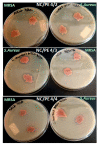Plant-Derived Nanocellulose with Antibacterial Activity for Wound Healing Dressing
- PMID: 38140013
- PMCID: PMC10747278
- DOI: 10.3390/pharmaceutics15122672
Plant-Derived Nanocellulose with Antibacterial Activity for Wound Healing Dressing
Abstract
The medical sector is one of the biggest consumers of single-use materials, and while the insurance of sterile media is non-negotiable, the environmental aspect is a chronic problem. Nanocellulose (NC) is one of the safest and most promising materials that can be used in medical applications due to its valuable properties like biocompatibility and biodegradability, along with its good mechanical properties and high water uptake capacity. However, NC has no bactericidal activity, which is a critical need for the effective prevention of infections in chronic diabetic wound dressing applications. Therefore, in this work, a natural product, propolis extract (PE), was used as an antibacterial agent, in different amounts, together with NC to obtain sponge-like structures (NC/PE). The scanning electron microscope (SEM) images showed well-impregnated cellulose fibers and a more compact structure with the addition of PE. According to the thermogravimetric analysis (TGA), the samples containing PE underwent thermal degradation before the unmodified NC due to the presence of volatile compounds in the extract. However, the peak degradation temperature in the first derivative thermogravimetric curves was higher for all the sponges containing PE when compared to the unmodified NC. The antibacterial efficacy of the samples was tested against Staphylococcus aureus, Pseudomonas aeruginosa, and Escherichia coli, as well as on two clinically resistant isolates. The samples completely inhibited the development of Staphylococcus aureus, and Pseudomonas aeruginosa was partially inhibited, while Escherichia coli was resistant to the PE action. Considering the physical and biological properties along with the environmental and economic benefits, the development of an NC/PE wound dressing seems promising.
Keywords: antibacterial; cellulose nanofibers; propolis; sponges; wound dressing.
Conflict of interest statement
The authors declare no conflict of interest.
Figures








References
-
- Panaitescu D.M., Frone A.N., Chiulan I. Nanostructured biocomposites from aliphatic polyesters and bacterial cellulose. Ind. Crop. Prod. 2016;93:251–266. doi: 10.1016/j.indcrop.2016.02.038. - DOI
Grants and funding
LinkOut - more resources
Full Text Sources
Molecular Biology Databases

